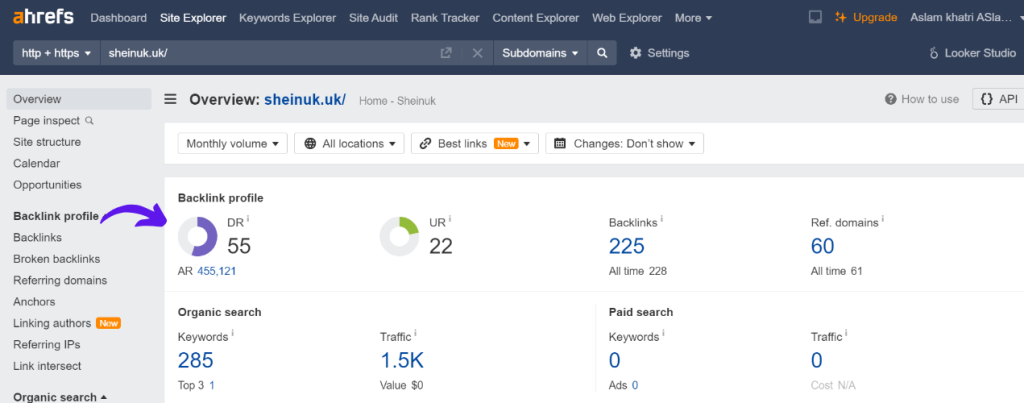Understanding Domain Rating (DR) and Domain Authority (DA)

In the realm of SEO (Search Engine Optimization), two terms that frequently pop up are Domain Rating (DR) and Domain Authority (DA). These metrics serve as key indicators of a website’s credibility and influence in the digital landscape. Let’s delve into a comprehensive guide to understand what DR and DA entail and how they impact your website’s online presence.
What is Domain Rating (DR)?
Domain Rating (DR) is a metric developed by SEO tool provider Ahrefs to assess the backlink profile of a website. It measures the quantity and quality of backlinks pointing to a specific domain on a logarithmic scale from 0 to 100. The higher the DR score, the stronger the backlink profile of the domain.

Factors Influencing Domain Rating (DR)
Several factors contribute to a website’s Domain Rating, including:
- Quality Backlinks: Backlinks from authoritative and relevant websites significantly enhance DR.
- Link Diversity: A diverse portfolio of backlinks from various sources strengthens DR.
- Link Velocity: The rate at which a website gains new backlinks influences DR.
- Content Quality: High-quality content attracts more backlinks, thus boosting DR.
- Website Age: Older websites tend to have higher DR scores due to accumulated backlinks over time.
Importance of Domain Rating (DR)
DR plays a crucial role in determining a website’s authority and visibility in search engine results pages (SERPs). Websites with higher DR scores are more likely to rank well for competitive keywords, attract organic traffic, and enjoy better online visibility.
What is Domain Authority (DA)?
Domain Authority (DA), on the other hand, is a metric developed by Moz that predicts a website’s ability to rank in search engine results. Like DR, DA also ranges from 0 to 100, with higher scores indicating stronger authority and ranking potential.

Factors Influencing Domain Authority (DA)
Similar to DR, several factors influence a website’s Domain Authority:
- Backlink Profile: The quality and quantity of backlinks significantly impact DA.
- Content Relevance: Relevant and authoritative content contributes to a higher DA score.
- Website Performance: Factors like site speed, user experience, and mobile-friendliness influence DA.
- Social Signals: Engagement on social media platforms can indirectly impact DA.
- Domain Age: Older domains tend to have higher DA scores due to accumulated authority over time.
Importance of Domain Authority (DA)
Domain Authority serves as a valuable metric for evaluating a website’s competitiveness in search engine rankings. Websites with higher DA scores are more likely to outrank competitors, attract organic traffic, and establish credibility within their niche.
Key Differences Between Domain Rating (DR) and Domain Authority (DA)
While both DR and DA measure a website’s authority and influence, they differ in their methodologies and focus areas.
- Measurement: DR primarily focuses on assessing the backlink profile of a domain, whereas DA considers various factors beyond backlinks, including website performance and social signals.
- Scale: DR and DA use different scales (0 to 100), making direct comparisons challenging.
- Tool Providers: DR is a metric provided by Ahrefs, while DA is developed and provided by Moz.
How to Improve Domain Rating (DR) and Domain Authority (DA)
Boosting your website’s DR and DA requires a strategic approach and continuous effort. Here are some effective strategies to enhance these metrics:
- Quality Content Creation: Publish high-quality, relevant content that attracts natural backlinks and engages your audience.
- Link Building: Focus on acquiring backlinks from authoritative and relevant websites through outreach, guest blogging, and content partnerships.
- Technical SEO Optimization: Ensure your website is technically optimized for search engines, including mobile-friendliness, site speed, and structured data markup.
- Social Media Engagement: Actively engage with your audience on social media platforms to increase brand visibility and generate social signals.
- Regular Website Audits: Conduct regular audits to identify and fix any technical issues, improve content quality, and optimize your backlink profile.
By implementing these strategies consistently, you can gradually enhance your website’s Domain Rating and Domain Authority, thus improving its overall visibility and competitiveness in the digital landscape.
Quality Content Creation
Creating high-quality content is the cornerstone of any successful SEO strategy. Not only does it attract natural backlinks from authoritative sources, but it also engages your audience and establishes your website as a valuable resource within your niche. When crafting content, focus on relevance, originality, and value to the reader. Conduct thorough keyword research to identify topics and keywords with high search volume and low competition. Additionally, leverage multimedia elements such as images, videos, and infographics to enhance the overall user experience and encourage social sharing.

Link Building Strategies
Link building remains a fundamental aspect of improving Domain Rating (DR) and Domain Authority (DA). However, it’s essential to adopt a strategic approach to avoid spammy or low-quality backlinks that could harm your website’s reputation. Instead, prioritize acquiring backlinks from authoritative and relevant websites within your industry. Explore opportunities for guest blogging, outreach campaigns, and content collaborations with influencers or industry experts. Additionally, monitor your backlink profile regularly using tools like Ahrefs or Moz to identify and disavow any toxic or harmful links.
Technical SEO Optimization
Technical SEO optimization involves optimizing various aspects of your website to improve its visibility and performance in search engine results. This includes ensuring mobile-friendliness, optimizing site speed, implementing structured data markup, and optimizing metadata such as title tags and meta descriptions. A well-optimized website not only enhances user experience but also signals to search engines that your site is trustworthy and authoritative, thereby positively impacting your Domain Authority (DA) and Domain Rating (DR).
Social Media Engagement
Social media platforms play a crucial role in driving traffic to your website and increasing brand visibility. Active engagement on social media not only fosters a sense of community but also generates valuable social signals that can indirectly impact your Domain Authority (DA). Share your content across various social media channels, engage with your audience through comments and messages, and participate in relevant conversations within your industry. Encourage social sharing by incorporating social sharing buttons on your website and creating shareable content that resonates with your audience.
Regular Website Audits
Regular website audits are essential for identifying and addressing any technical issues, content gaps, or opportunities for improvement. Conduct comprehensive audits of your website’s performance, backlink profile, content quality, and overall SEO health. Use tools like Google Analytics, Google Search Console, and website auditing software to analyze key metrics, identify areas for optimization, and track your progress over time. By staying proactive and vigilant, you can continuously improve your website’s Domain Rating (DR) and Domain Authority (DA) and maintain a competitive edge in the ever-evolving landscape of SEO.
In conclusion, improving your website’s Domain Rating (DR) and Domain Authority (DA) requires a multifaceted approach that encompasses quality content creation, strategic link building, technical SEO optimization, social media engagement, and regular website audits. By implementing these strategies consistently and diligently, you can enhance your website’s visibility, credibility, and competitiveness in search engine results.
